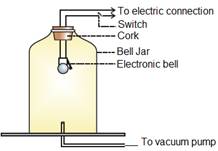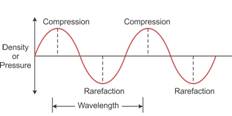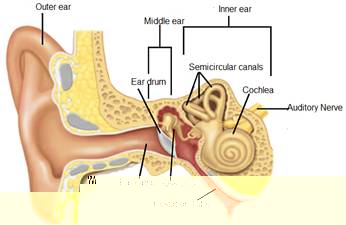The objects vibrating and produce sound. Vibration means a kind of rapid to and fro motion of an object. The sound of the human voice is produced due to vibrations in the vocal cords.
Sound is a form of energy which produces a sensation of hearing in our ears. There are also other forms of energy like mechanical energy, light energy, etc.
Sound is produced by vibrating objects. The matter or substance through which sound is transmitted is called a medium. It can be solid, liquid or gas. Sound moves through a medium from the point of generation to the listener. When an object vibrates, it sets the particles of the medium around it vibrating. The particles do not travel all the way from the vibrating object to the ear. A particle of the medium in contact with the vibrating object is first displaced from its equilibrium position.
Sound waves are characterised by the motion of particles in the medium and are called mechanical waves. When a vibrating object moves forward, it pushes and compresses the air in front of it creating a region of high pressure. This region is called a compression (C). This compression starts to move away from the vibrating object.
When the vibrating object moves backwards, it creates a region of low pressure called rarefaction (R).
So, the propagation of sound can be visualised as propagation of density variations or pressure variations in the medium.
Sound is a mechanical wave and needs a material medium like air, water, steel etc. for its propagation. It cannot travel through vacuum.
An electric bell and an airtight glass bell jar. The electric bell is suspended inside the airtight bell jar. The bell jar is connected to a vacuum pump When the air in the jar is pumped out gradually, the sound becomes fainter, although the same current is passing through the bell. After some time when less air is left inside the bell jar you will hear a very feeble sound.

The propagation of disturbance in a slinky with the sound propagation in the medium. These waves are called longitudinal waves.
The particles do not move from one place to another but they simply oscillate back and forth about their position of rest and a sound wave propagates, hence sound waves are longitudinal waves.
A transverse wave particles do not oscillate along the direction of wave propagation but oscillate up and down about their mean position as the wave travels. Thus, a transverse wave is the one in which the individual particles of the medium move about their mean positions in a direction perpendicular to the direction of wave propagation.
Light is a transverse wave but for light, the oscillations are not of the medium particles or their pressure or density — it is not a mechanical wave.
Compressions are the regions where particles are crowded together and represented by the upper portion of the curve.
Rarefactions are the regions of low pressure where particles are spread apart and are represented by the valley, that is, the lower portion of the curve.

A peak is called the crest and a valley is called the trough of a wave.
The distance between two consecutive compressions (C) or two consecutive rarefactions (R) is called the wavelength, The wavelength is usually represented by λ (Greek letter lambda). Its SI unit is metre (m).
The number of such oscillations per unit time is the frequency of the sound wave. The SI unit of frequency was named as hertz.
The time taken by two consecutive compressions or rarefactions to cross a fixed point is called the time period of the wave.
The time taken for one complete oscillation is called the time period of the sound wave. It is represented by the symbol T. Its SI unit is second (s). Frequency and time period are related as follows:
v = 1/T
The frequency of an emitted sound is called its pitch. The faster the vibration of the source, the higher is the frequency and the higher is the pitch. a high pitch sound corresponds to more number of compressions and rarefactions passing a fixed point per unit time.
Objects of different sizes and conditions vibrate at different frequencies to produce sounds of different pitch.
The loudness or softness of a sound is determined basically by its amplitude. The amplitude of the sound wave depends upon the force with which an object is made to vibrate.
Louder sound can travel a larger distance as it is associated with higher energy.
The quality or timber of sound is that characteristic which enables us to distinguish one sound from another having the same pitch and loudness. The sound which is more pleasant is said to be of a rich quality. A sound of single frequency is called a tone. The sound which is produced due to a mixture of several frequencies is called a note and is pleasant to listen to. Noise is unpleasant to the ear! Music is pleasant to hear and is of rich quality.
The speed of sound is defined as the distance which a point on a wave, such as a compression or a rarefaction, travels per unit time.
Speed, v = distance/time
U = λ/T
Here λ is the wavelength of the sound wave. It is the distance travelled by the sound wave in one time period (T) of the wave. Thus
U = λV
That is, speed = wavelength x frequency.
The speed of sound remains almost the same for all frequencies in a given medium under the same physical conditions.
Sound propagates through a medium at a finite speed. The sound of a thunder is heard a little later than the flash of light is seen.
When sound travels with a speed which is much less than the speed of light. The speed of sound depends on the properties of the medium through which it travels.
The speed of sound in a medium depends on temperature of the medium. The speed of sound decreases when we go from solid to gaseous state. In any medium as we increase the temperature, the speed of sound increases.
The sound gets reflected at the surface of a solid or liquid. The directions in which the sound is incident and is reflected make equal angles with the normal to the reflecting surface at the point of incidence, and there are in the same plane.
The sound which we hear is called an echo. The sensation of sound persists in our brain for about 0.1 s. To hear a distinct echo the time interval between the original sound and the reflected one must be at least 0.1s.
For hearing distinct echoes, the minimum distance of the obstacle from the source of sound must be half of this distance.
The repeated reflection that results in this persistence of sound is called reverberation. In an auditorium or big hall excessive reverberation is highly undesirable.
Megaphones or loudhailers, horns, musical instruments such as trumpets and shehanais, are all designed to send sound in a particular direction without spreading it in all directions.
Stethoscope is a medical instrument used for listening to sounds produced within the body, mainly in the heart or lungs.
Generally the ceilings of concert halls, conference halls and cinema halls are curved so that sound after reflection reaches all corners of the hall.
The audible range of sound for human beings extends from about 20 Hz to 20000 Hz (one Hz = one cycle/s). Children under the age of five and some animals, such as dogs can hear up to 25 kHz (1 kHz = 1000 Hz).
Sounds of frequencies below 20 Hz are called infrasonic sound or infrasound.
Frequencies higher than 20 kHz are called ultrasonic sound or ultrasound. Ultrasound is produced by animals such as dolphins, bats and porpoises.
Ultrasounds are high frequency waves. Ultrasounds are able to travel along welldefined paths even in the presence of obstacles. Ultrasounds are used extensively in industries and for medical purposes.
Ultrasound is generally used to clean parts located in hard-to-reach places,
Ultrasounds can be used to detect cracks and flaws in metal blocks. Metallic components are generally used in construction of big structures like buildings, bridges, machines and also scientific equipment.
Ordinary sound of longer wavelengths cannot be used for such purpose as it will bend around the corners of the defective location and enter the detector.
Ultrasonic waves are made to reflect from various parts of the heart and form the image of the heart. This technique is called ‘echocardiography’.
Ultrasound scanner is an instrument which uses ultrasonic waves for getting images of internal organs of the human body.
Ultrasound may be employed to break small ‘stones’ formed in the kidneys into fine grains. These grains later get flushed out with urine.
The acronym SONAR stands for Sound Navigation and Ranging. Sonar is a device that uses ultrasonic waves to measure the distance, direction and speed of underwater objects.
Sonar consists of a transmitter and a detector and is installed in a boat or a ship.
The transmitter produces and transmits ultrasonic waves. These waves travel through water and after striking the object on the seabed, get reflected back and are sensed by the detector. The detector converts the ultrasonic waves into electrical signals which are appropriately interpreted. The distance of the object that reflected the sound wave can be calculated by knowing the speed of sound in water and the time interval between transmission and reception of the ultrasound.
The sonar technique is used to determine the depth of the sea and to locate underwater hills, valleys, submarine, icebergs, sunken ship etc.
We are able to hear with the help of an extremely sensitive device called the ear. It allows us to convert pressure variations in air with audible frequencies into electric signals that travel to the brain via the auditory nerve.

The outer ear is called ‘pinna’. It collects the sound from the surroundings. The collected sound passes through the auditory canal. At the end of the auditory canal there is a thin membrane called the ear drum or tympanic membrane. The vibrations are amplified several times by three bones (the hammer, anvil and stirrup) in the middle ear. The middle ear transmits the amplified pressure variations received from the sound wave to the inner ear.
